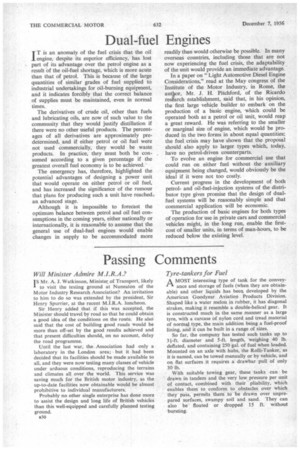Passing Comments
Page 38

Page 39

If you've noticed an error in this article please click here to report it so we can fix it.
Will Minister Admire M.I.R.A.?
IS Mr. A. J. Watkinson, Minister of Transport, likely to visit the testing ground at Nuneaton of the Motor Industry Research Association? An invitation to him to do so was extended by the president, Sir Henry Spurrier, at the recent M.I.R.A. luncheon. Sir Henry added that if this was accepted, the Minister should travel by road so that he could obtain a good idea of the conditions on the route. He also said that the cost of building good roads would be more than off-set by the good results achieved and that present difficulties should, on no account, delay the road programme.
Until the last war, the Association had only a laboratory in the London area; but it had been decided that its facilities should be made available to all, and they were now testing many classes of vehicle under arduous conditions, reproducing the terrains and climates all over the world. This service was saving much for the British motor industry, as the up-to-date facilities now obtainable would be almost prohibitive to individual manufacturers.
Probably no other single enterprise has done more to assist the design and long life of British vehicles than this well-equipped and carefully planned testing ground.
630
Tyre-tankers for Fuel
A MOST interesting type of tank for the convey" ance and storage of fuels (when they are obtainable) and other liquids has been developed by the American Goodyear Aviation Products Division. Shaped like a water melon in rubber, it has diagonal strakes, making it resemble a double-helical gear. It is constructed much in the same manner as a large tyre, with a carcase of nylon cord and tread material of normal type, the main addition being a fuel-proof lining, and it can be built in a range of sizes.
So far, the company has tested such tanks up to 34-ft. diameter and 5-ft. length, weighing 40 lb. deflated, and containing 250 gal. of fuel when loaded. Mounted on an axle with hubs, the Roth-Tanker, as it is named, can be towed manually or by vehicle, and on flat surfaces it requires a drawbar pull of only 30 lb.
With suitable towing gear, these tanks can be drawn in tandem and the very low pressure per unit of contact, combined with their pliability, which enables them to conform to obstacles over which they pass, permits them to be drawn over unprepared surfaces, swampy soil and sand. They can also be floated or dropped 15 ft. without bursting.
The Roads Were Not Whole
THERE is always a risk of accidents on the road
but on occasions, fortunately infrequent, there may also be a danger of falling through the surface.
Only recently at Bere Alston in Devon, the driver of a road roller noticed a hole in the road as he was passing over it. This proved to lead into a shaft of a disused tin mine, some 70 ft. deep, and only the unsupported road prevented traffic from falling into it.
Many years ago, a London surveyor telephoned to the offices of this journal during the time Holborn was being relaid, and a representative was invited to visit a spot near the junction with Gray's Inn Road. Here a road mender's pick had gone through into a similar deep hole, which was found to be part of an underground river, probably the Holbourne, from which Holborn gained its name. The former timber supports had rotted away and, consequently, half the road had been acting as a bridge, over which hundreds of buses and other traffic passed daily.
Bees Gave the Idea
DUFAYLITE honeycomb structures for industrial • and domestic purposes appear to be increasing rapidly. Originally developed during the past war, in co-operation with the plastics section of the Royal Aircraft Establishment, Farnborough, the main use of this product of Dufaylite Developments, Ltd., Boreham Wood, Herts, is as a low-density core of paper, metal foil or glasspol sandwiched between thin skins of higher-density materials. The latter may be plywood, metal or sheets of plastics or asbestos. It is extremely light and strong and is claimed to be water-repellent, fire-resistant and to possess heatand sound-insulation properties.
Consisting of hexagonal cells, the meshes of which vary according to the materials used in the construction and to meet customers' requirements, Dufaylite is employed for building, packaging, diffused lighting, flush-door making and for many other purposes where its unusual attributes show themselves to be advantageous.




























































































































